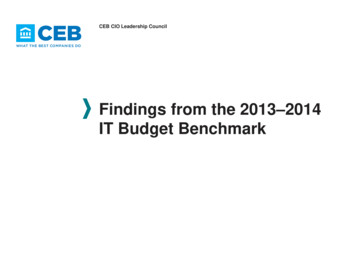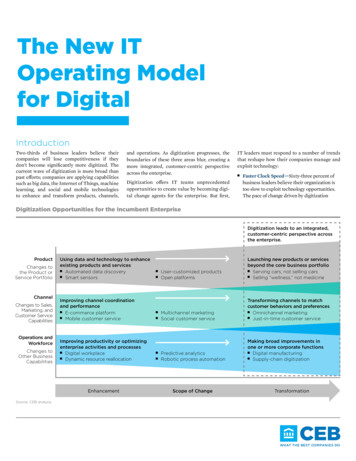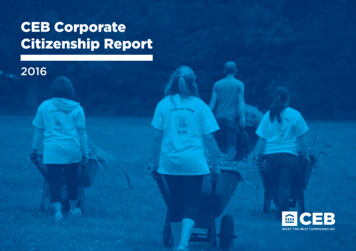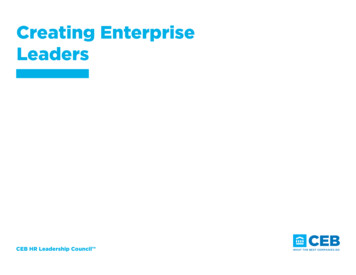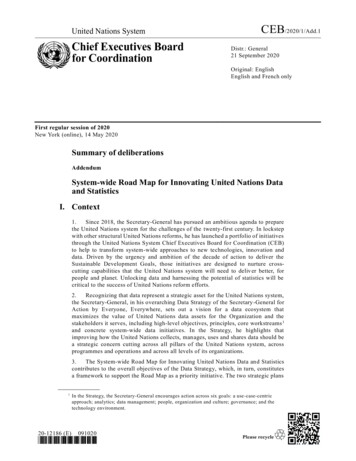
Transcription
United Nations SystemChief Executives Boardfor CoordinationCEB/2020/1/Add.1Distr.: General21 September 2020Original: EnglishEnglish and French onlyFirst regular session of 2020New York (online), 14 May 2020Summary of deliberationsAddendumSystem-wide Road Map for Innovating United Nations Dataand StatisticsI. Context1.Since 2018, the Secretary-General has pursued an ambitious agenda to preparethe United Nations system for the challenges of the twenty-first century. In lockstepwith other structural United Nations reforms, he has launched a portfolio of initiativesthrough the United Nations System Chief Executives Board for Coordination (CEB)to help to transform system-wide approaches to new technologies, innovation anddata. Driven by the urgency and ambition of the decade of action to deliver theSustainable Development Goals, those initiatives are designed to nurture crosscutting capabilities that the United Nations system will need to deliv er better, forpeople and planet. Unlocking data and harnessing the potential of statistics will becritical to the success of United Nations reform efforts.2.Recognizing that data represent a strategic asset for the United Nations system,the Secretary-General, in his overarching Data Strategy of the Secretary -General forAction by Everyone, Everywhere, sets out a vision for a data ecosystem thatmaximizes the value of United Nations data assets for the Organization and thestakeholders it serves, including high-level objectives, principles, core workstreams 1and concrete system-wide data initiatives. In the Strategy, he highlights thatimproving how the United Nations collects, manages, uses and shares data should bea strategic concern cutting across all pillars of the United Nations system, acrossprogrammes and operations and across all levels of its organizations.3.The System-wide Road Map for Innovating United Nations Data an d Statisticscontributes to the overall objectives of the Data Strategy, which, in turn, constitutesa framework to support the Road Map as a priority initiative. The two strategic plans120-12186 (E)In the Strategy, the Secretary-General encourages action across six goals: a use-case-centricapproach; analytics; data management; people, organization and culture; governance; and thetechnology environment.091020*2012186*
CEB/2020/1/Add.1converge around a vision in which the power of data is recognized and the UnitedNations is encouraged to embrace a more coherent and modern approach to data. Thefocus of the Strategy is the internal functioning of the United Nations itself. It is ahigh-level plan that identifies actions, at the United Nations entity leve l and acrossthe Organization as a whole, through which improvements can be made with regardto United Nations data. The Data and Statistics Road Map is a complementarystrategic plan, albeit also high-level, that is more operational in focus and that buildsupon and connects existing professional networks. The Road Map also has twoconstituencies in mind, both the United Nations system itself (where it overlaps withthe Strategy) and national statistical systems, by offering more coordinated statisticalassistance. The Road Map is aimed at improving not only United Nations data, butalso United Nations statistics. 24.Thus, the actions described in the Data and Statistics Road Map are aimed atpromoting innovation with regard to United Nations data and statistical outputs inrelation to the two roles played by United Nations entities in this arena, which are:(a) to support the development of national statistical systems, thereby helpingcountries to produce fit-for-purpose data and statistics; and (b) to provideauthoritative regional and global data and statistics to support the internationalcommunity in responding in a timely fashion to regional and emerging policy needs.The Road Map will also help to deliver on one of the initiatives of the Data Strateg y,namely, transforming the statistics portal (data.un.org) in order to strengthen theposition of the United Nations system as a primary provider of global data andstatistics, and two data-related initiatives recommended by the Secretary-General forregional reform, namely, the creation of knowledge management hubs andcollaboration on data and statistics.II. Introduction5.At the thirty-eighth session of the High-level Committee on Programmes, heldin October 2019 in Turin, Italy, the Committee of the Chief Statisticians of the UnitedNations System presented a conference room paper entitled “The contribution ofUnited Nations data to the 2030 Agenda and United Nations reform: innovating nowfor better information in the future” (CEB/2019/HLCP38/CRP.3). In its paper, theCommittee set out some general proposals that, if adopted, would help the UnitedNations data and statistics system to better contribute to: (a) addressing the needsalready identified by the High-level Committee on Programmes with regard toimproving the availability and timeliness of data and statistics; (b) supporting thedecade of action to deliver the Sustainable Development Goals by 2030 and thereformed United Nations development system; and (c) delivering on the challengesset out by the Independent Expert Advisory Group on the Data Revolution forSustainable Development in its 2014 report, entitled “A world that counts: mobilisingthe data revolution for sustainable development”, and in the declaration issued at theUnited Nations World Data Forum held in Dubai in 2018, entitled “Supporting theImplementation of the Cape Town Global Action Plan for Sustainable DevelopmentData”, in which new solutions, new actors, new ideas and new partnerships werecalled for.6.The High-level Committee on Programmes, after considering the conferenceroom paper, requested the Committee of the Chief Statisticians of the United NationsSystem to prepare, in collaboration with interested Committee members, a draft road22/20See annex for a visualization of the links between the System -wide Road Map for InnovatingUnited Nations Data and Statistics and the Data Strategy of the Secretary-General for Action byEveryone, Everywhere: With Insight, Impact and Integrity.20-12186
CEB/2020/1/Add.1map and system-wide approach for modernizing United Nations data and statistics,to be considered at its thirty-ninth session (see CEB/2019/6). In doing so, the Highlevel Committee stressed the need to take into consideration the usability and qualityof new data sources and platforms, while underscoring the significance ofstrengthening the capacities of national institutions and statistics offices to improvethe collection and analysis of official data and to make use of new data sources to fillremaining data gaps with regard to the Sustainable Development Goals. The High level Committee further underlined the importance of strengthening the capacity ofthe United Nations system for data innovation by engaging and efficientlycoordinating and pooling existing partnership networks with the private sector andthe research community, reducing fragmentation and silos and strengthening thecapacity of United Nations staff to effectively use and analy se data. They also notedthe need for data privacy, data security, ethical guidelines for new data sources andsafeguards against biases to be addressed.7.In section A of the Data and Statistics Road Map, the Committee of the ChiefStatisticians of the United Nations System sets out a vision, a mission statement anda set of values for the United Nations system. In section B, the Committee sets outsome general problem statements, both actual and perceived, categorized as cultural,technical or institutional challenges. Section C contains such details as the actions tobe taken, existing resources that can support those actions, a list of the most suitableactors and a timeline for implementation.8.The Data and Statistics Road Map contains a set of ambitious and aspirationaltargets whose achievement will require time, resources and a shift of priorities by thecurrent statistical and data programmes. It will require continuous coordination withthe drivers of the Data Strategy. Accelerating and achieving the innovation to whichthese targets aspire will also require leadership from the Committee of the ChiefStatisticians of the United Nations System and the strong political commitment ofUnited Nations leaders and the long-term engagement of those United Nationscommunities that can make that happen.III. Data and Statistics Road MapA.Vision, mission and valuesVisionTo contribute to a better world through timely, trusted data and statistics for everyone.Mission To guide and advise Member States, to lead and coordinate the United Nationsstatistical system, to convene to develop normative standards and internationalbest practices and to support countries with capacity development. To open United Nations data to help people and communities access, use andunderstand data and statistics, to bring trust into public discourse and toempower and protect people by providing inclusive and impartial statistics. To improve statistical literacy and to provide and communicate trusted Un itedNations data and statistics within and outside the United Nations in a way thatit can be easily understood and used. To innovate and to grow and promulgate the United Nations data and statisticsbrand.20-121863/20
CEB/2020/1/Add.1Values A deep commitment to impartial, open United Nations data and statistics as aglobal public good. A culture of service, consultation and engagement, collaboration, responsiveness,accountability and efficiency. The highest standards of ethical professionalism, leadership and trust, includingadherence to the principles governing international statistical activities andapplying those principles beyond statistics to all publicly available UnitedNations data.B.ChallengesInternal challenges9.Implementing the vision of a modernized United Nations system that contributesto a better world with timely and trusted data and statistics requires overcoming somechallenges within the United Nations itself. These can be categorized as institutional,cultural or technical challenges, as follows:(a) Institutional challenges. The data and statistical systems of the UnitedNations are not sufficiently coordinated or interoperable to support the decade foraction to deliver the Sustainable Development Goals, are constrained by a lack of dataand limited resources, are separated from policy and lack a coherent brand (for bothdata and capacity development);(b) Cultural challenges. United Nations system data and statistical functionsare perceived as being too slow, too reactive, too fragmented, too risk averse and tooconservative, as having an inability to communicate with each other and as using toomuch statistical jargon;(c) Technical challenges. United Nations system data and statisticalspecialists lack continuous professional development and may lack necessaryknowledge and skills, in particular with regard to new data sources and new statisticaltechniques, including those intended to safeguard confidentiality and privacy.External challenges10. Implementing that vision also requires overcoming some external challenges.These can be categorized as relating to country capacity or resources, as follows:(a) Country capacity. Not all countries have sufficient capacity to produceaccurate and timely statistics and to respond to new data demands, which limits theproduction of high-quality international statistics;(b) Resources. Many national statistical systems have limited resources,which limits their activities.C.Overview11. The actions described in the Data and Statistics Road Map are aimed atpromoting innovation with regard to United Nations data and statistical outputs, inrelation to the two roles played by United Nations entities in this arena, which are:(a) To support the development of national statistical systems, thereby helpingcountries to produce fit-for-purpose data and statistics;4/2020-12186
CEB/2020/1/Add.1(b) To provide authoritative regional and global data and statistics to supportthe international community in responding in a timely fashion to regional andemerging policy needs.12. The Data and Statistics Road Map covers data and statistics relating to all threepillars of the United Nations: peace and security, human rights and development. Italso includes humanitarian assistance. It builds on the Secretary-General’s vision ofa data ecosystem that maximizes the values of United Nations data assets for theOrganization and the stakeholders it serves and his recommendations for regional andglobal collaboration on data and statistics.13. The Data and Statistics Road Map is also aimed at promoting innovation inUnited Nations data and statistical coordination and communication by:(a) Incorporating the three goals identified by the Independent ExpertAdvisory Group in its report, “A world that counts”; 3(b) Supporting the four initiatives agreed upon by CEB for a United Nationsapproach to the data revolution; 4(c) Championing the four data initiatives identified by the Secretary -Generalin Executive Committee decision 2019/64 on the need for a United Nations datastrategy. 514.The Data and Statistics Road Map is presented in the form of three goals: Goal 1: Create new and timely data solutions Goal 2: Address emerging policy needs Goal 3: Provide coordinated and innovative support to Member States15. The Data and Statistics Road Map also dovetails other strategic plans that areaimed at improving the integration and flow of information in order to address policygoals and crisis response. 6 Each of the goals in the Road Map includes a number oftargets and details on the actions envisaged to achieve their implementation. Theactors most suitable for carrying out that implementation are identified, a timeline isprovided and existing resources that can support each action are suggested.Associated risks and opportunities are also identified.345620-12186Those goals are: (a) technology, innovation and analysis; (b) capacity and resources; and(c) governance and leadership.Those initiatives are: (a) to expand capacity to drive data innovation through the development ofa United Nations system data innovation laboratory; (b) to strengthen data exchange andcommunication capabilities across the United Nations system by seeking to create the foundationfor data visualization and dashboard capability across the system; (c) to create and strengthenpartnerships for coordination and capacity-building in data-driven sustainable developmentthrough a world forum on sustainable development data; and (d) to promote the greater use ofexisting data assets within the United Nations system and by the public through the creation of aUnited Nations system data catalogue (see CEB/2015/1).Those initiatives are: (a) transparency, including a new open portal (open.un.org);(b) accessibility, including a stronger data portal (data.un.org); (c) interoperability, including astronger application programming interface service (ap i.un.org); and (d) literacy, including newjob profiles for data analysts, specialists and scientists.Other strategic plans include: Transforming our world: the 2030 Agenda for SustainableDevelopment; the Data for Now initiative; the draft geospatial strategy for the United Nations;the Secretary-General’s strategy on new technologies; the Data Standards for United NationsSystem-wide Reporting of Financial Data and the personal data protection and privacy principlesof the High-level Committee on Management; the common country analysis underpinning theUnited Nations Sustainable Development Cooperation Framework; and the Data Strategy of theSecretary-General.5/20
CEB/2020/1/Add.116. While overall accountability for the Data Strategy rests with the ExecutiveCommittee, accountability for the Data and Statistics Road Map remains with theHigh-level Committee on Programmes, with the Committee of the Chief Statisticiansof the United Nations System as the main body mandated to monitor and report on itsprogress.6/2020-12186
20-12186Goal 1. Create new and timely data solutionsThe United Nations system creates new data solutions using multiple data sources that address emerging policy issues and describe “what matters, whenit matters”.Target 1.1To improve existing data sources and increase use of new data sources to expand coverage, re levance and timeliness of data and statistics produced anddisseminated by the United Nations system.ActionResourceActorTimelineEstablish a United Nations data collaborativeExisting resources1.1.1 Share information, methodologies andgood practices for adopting new data sourcesUnited Nations Global Platformand Global Working Group onBig Data for Official StatisticsStatistics Division of theDepartment of Economic andSocial Affairs and Global Pulse(lead) on action 1.1.1June 2020: establishment ofnew global working group(action 1.1.2)1.1.2 Establish a global working group forUnited Nations system entities aBig Data for Migration Alliance1.1.3 Establish and manage United Nations-level Global Pulseagreements with external providers to ensureData for Now initiativesustainable access to secondary data, inFederated Information Systemparticular big data bfor the SustainableDevelopment Goals1.1.4 Strengthen the link between UnitedNations statistics and geospatial systems,including establishing a network of UnitedNations staff that use geospatial information toproduce and disseminate United Nations dataand statistics, and provide relevant training toUnited Nations staff cStatistical Commission digitaltransformation network (workon information technologystandards for new data)1.1.5 Strengthen the link between the UnitedNations statistical system and citizen sciencedata communitiesUnited Nations developmentsystem regional reformrecommendationsCommittee of Experts on GlobalGeospatial InformationManagementUnited Nations GeospatialNetwork7/20Committee of the ChiefStatisticians of the UnitedNations System and Committeeof Experts on Global GeospatialInformation Management toestablish a United Nationsstatistics/geospatial network,building on the existing work ofthe United Nations SystemNetwork on geospatialinformation and initiatives onintegrating statistical, geospatialand other data sources by theStatistics Division, theEconomic Commission forEurope, the EconomicCommission for Latin Americaand the Caribbean, theEconomic and SocialDecember 2020: someagreements signed (action 1.1.3)December 2020: first new data/statistics released by someUnited Nations entities usingnew data sources (goal 1)2020/21: increased number ofUnited Nations entities releasingdata and statistics based on newdata sources (goal 1)June 2020: first meeting/workshop of statistics/geospatial network (action 1.1.4)December 2020: technicalnetwork of United Nations staffusing geospatial informationsystem established (action 1.1.4)2020–2021: more UnitedNations entities integratingstatistical, geospatial and otherdata sources to provide betterknowledge and insights(action 1.1.4)CEB/2020/1/Add.1Office for Outer Space AffairsGlobal Working Group andStatistics Division onactions 1.1.2 and 1.1.3; data andstatistical programmes of allUnited Nations entities toparticipate in the new globalworking group
ResourceActorTimelineResources neededCommission for Asia and thePacific and others that havealready started to embedgeospatial information systemin their data and statistics(action 1.1.4)December 2020: establishmentof joint Committee of the ChiefStatisticians-citizen science datacommunity group (action 1.1.5)Global Pulse to support UnitedNations agencies inexperimenting with andadopting new data sources on asubnational, national, regionaland global scale; StatisticsDivision of the Department ofEconomic and Social Affairs tolead the establishment of a newglobal working group for UnitedNations agenciesLead agency to devote time toestablishing the technicalnetwork and making itproductive for all UnitedNations entitiesOffice for Outer Space Affairsto support action 1.1.4 ondelivering capacity-building forand planning of dedicatedworkshopsCommittee of the ChiefStatisticians to form a workinggroup on citizen science datawith academic communityworking on such data(action 1.1.5)Risks: Member States oppose the use of alternative sources not based on their official data, lack the capacity to access and benefit from existing newdata solutions or to implement and/or use tools for data interoperability or lack the skills to establish partnerships , and a lack of resources among UnitedNations entities prohibits implementation.Opportunities: to engage the Statistical Commission and the Committee of Experts on Global Geospatial Information Management as forums fordiscussion with Member States on the use of new sources by th e United Nations system.abcThe existing Global Working Group on Big Data for Official Statistics is a forum f or countries to adopt new data sources; the new global working group for United Nationsagencies would support the use of new sources within Un ited Nations agencies.This action operationalizes some of the activities under the Data Strategy of the Secre tary-General for Action by Everyone, Everywhere, in particular those of the actionpillar on data environment and infrastructure and goal 6, on the technology environment. It will include any infrastructural requirements to operationalize the sharing ofdata.For example, dedicated workshops for United Nations system staff to exchange experiences and learn from each other with regard to the benefits of combining statistical,geospatial and other data sources.CEB/2020/1/Add.18/20Action20-12186
20-12186Target 1.2To ensure that United Nations staff have adequate skills to embrace the opportunities that new data sources, methodologies, technologies andcommunication channels offer in the field of data and statistics.ActionResourceActorTimelinePromote continuous professionaldevelopment of United Nations staff in dataand statistics aExisting resourcesOffice of Human Resourcesprofessional trainingprogrammes (to lead), withCommittee of the ChiefStatisticians of the UnitedNations System and Digital andTechnology Network, to developnew training curricula forUnited Nations personnel and astrategy to retain experts(action 1.2.1)March 2021: new trainingembedded in United Nationstraining curricula (action 1.2.1)1.2.1 Develop online and face-to-face technicalstatistical training programmes for UnitedNations staff on data communication, new datasources, methodological development andanalytical techniques1.2.2 Develop new United Nations job profilesfor data scientists, data analysts anddata/statistics communicators b1.2.3 Improve the efficiency and connectivityof United Nations database systemsDigital and TechnologyNetwork (High-level Committeeon Management)Office of Human Resourcesprofessional trainingprogrammesUnited Nations DevelopmentProgramme and Global PulseHigh-level Committee onManagement secretariat(common identifiers)United Nations System StaffCollegeInternational Fund forAgricultural DevelopmentUnited Nations developmentsystem regional reformrecommendationsResources neededFinancial resources to developnew United Nations trainingcurriculaHuman resources network (tolead), together with Committeeof the Chief Statisticians andDigital and TechnologyNetwork, to create new jobprofiles and a roster of UnitedNations experts to use toenhance data science within theUnited NationsJoint group comprisingCommittee of the ChiefStatisticians and Digital andTechnology Network to enhancedigitalization of data andinformation for statisticalpurposes (action 1.2.2)January 2021: roster of newUnited Nations job profiles(action 1.2.2)2021/22: roll-out of training inUnited Nations entities (action1.2.1)December 2020: establishmentof joint Committee of the ChiefStatisticians-Digital andTechnology Network group(action 1.2.3)December 2020: all UnitedNations entities have adoptedcommon identifiers(action 1.2.3)CEB/2020/1/Add.19/20Statistics Division of theDepartment of Economic andSocial Affairs (to lead) andCommittee of the ChiefStatisticians, with support fromthe High-level Committee onSeptember 2020: new jobprofiles established(action 1.2.2)
ResourceActorTimelineManagement secretariat, toadopt common identifiers(action 1.2.3)Risks: resources are not available to develop and roll out training , and administrative rules prevent the establishment of a common United Nations rosterof experts.Opportunities: to improve data and statistical literacy within the United Nations and to modernize the image of a career as a United Nations datascientist/statistician.abThis action operationalizes some of the activities under the Data Strategy of the Secretary-General for Action by Everyone, Everywhere, in particular those of the actionpillar on people and culture.This action operationalizes some of the activities under the Data Strategy.Target 1.3To maintain the integrity, trust and transparency of United Nations data and statistics so that t he United Nations system can fully embrace new datasources and methodology without undermining the authority of its data and statistics.ActionResourceActorTimelineStrengthen internal United Nations systempolicies, norms and standards that promotethe integrity of data and statistics aExisting resourcesCommittee for the Coordinationof Statistical Activities to leadon action 1.3.1December 2021: all UnitedNations entities meet the criteriafor open data (action 1.3.1)Committee of the ChiefStatisticians of the UnitedNations System (to lead), withthe Digital and TechnologyNetwork (High-level Committeeon Management), Committee ofExperts on Global GeospatialInformation Management andUnited Nations InnovationNetwork, to develop newstandards (actions 1.3.2 and1.3.3)March 2021: principlesgoverning internationalstatistical activities reviewedand updated if needed(action 1.3.4)1.3.1 All United Nations system entities toachieve full and responsible open data by 20211.3.2 Define responsible, ethical and qualitystandards for United Nations use of secondarydata, in particular big data (including dataconfidentiality, data privacy, data protection anddata security)1.3.3 Define standards for detecting andcountering bias that may be introduced byalgorithms and automatized systems20-121861.3.4 Review the principles governinginternational statistical activities in the light ofnew technologies and methodologies and updateif neededUnited Nations StatisticalQuality Assurance FrameworkUnited Nations Global Platformand Global Working Group onBig Data for Official StatisticsGlobal PulsePrinciples Relating to RemoteSensing of the Earth from OuterSpaceResources neededUnited Nations entities todevote time to developing theethical guidelinesCommittee for the Coordinationof Statistical Activities andStatistics Division of theMarch 2021: ethical and qualitystandards developed(actions 1.3.2 and 1.3.3)CEB/2020/1/Add.110/20Action
20-12186ActionResourceActorTimelineDepartment of Economic andSocial Affairs to lead onaction 1.3.4Risks: internal resistance within United Nations entities prevent all United Nations data and statistics from fulfilling the crite ria of open data, andinsufficient time and resources are devoted to developing responsible and ethical standards.Opportunities: to approach donors to provide financial resources to develop ethical guidelines.aThis action operationalizes some of the activities under the Data Strategy of th e Secretary-General for Action by Everyone, Everywhere, in particular those of the actionpillars on data assets and use and data privacy and protection.Goal 2. Address emerging policy needsData and statistics produced and disseminated by the United N ations system are used to address emerging policy needs.Target 2.1As a core United Nations system-wide initiative, to transform the data.un.org portal into a single point of reference for United Nations system data inorder to strengthen the position of the United Nations system as a p rimary provider of global data and statistics.ActionResourceTimelineStatistics Division to lead on thedesign, development andmaintenance of the portal andcoordination with UnitedNations system entities(actions 2.1.2, 2.1.3, 2.1.4 and2.1.5)June 2020: launch of thechallenge (action 2.1.1)United Nations TechnologyInnovation Labs to launch achallenge to explore technologythat can build an automatedonline United Nations dataportal (action 2.1.1)Statistics Division to lead onpromoting the United Nationsdata brand (action 2.3.2)2020/22: finalization of theportal (actions 2.1.2, 2.1.3,2.1.4 and 2.1.5)June 2020: interim solutionwith United Nations data portallisting websites where UnitedNations system entities presenttheir statisticsCEB/2020/1/Add.111/20Update the United Nations data portal so that Existing resourcesdata from system entities can be linked andUnited Nations Technologypresented under a unique United NationsInnovation Labsdata brandUnited Nations data portal2.1.1 Explore technology to establish an online(Statistics Division of theUnited Nations data portal where data identifiedDepartment of Economic andby United Nations system entities as “UnitedSocial Affairs)Nations data” can be automatically linked andpresentedRegional commission dataportals and Sustainable2.1.2 Rebrand United Nations dataDevelopment Goal gateways2.1.3 Update the United Nations data portalUnited Nations System Datawith new scopeCatalog2.1.4 Define common data and metadataInternational Fund forstandardsAgricultural Development2.1.5 Finalize the automatic upload of dataActor
Resource2.1.6 Adopt a common open data licence forall resources available through data.un.orgUnited Nations DevelopmentProgramme2.1.7 Develop interactive data exploration andvisualization toolsSpace4Water Portal, UnitedNations Platform for Spacebased Information for DisasterManagement and EmergencyResponse knowledge portal,country assessments and Spac
United Nations System CEB/2020/1/Add.1 Chief Executives Board for Coordination Distr.: General 21 September 2020 Original: English English and French only 20-12186 (E) 091020 *2012186* First regular session of 2020 New York (online), 14 May 2020 Summary of deliberations Addendum System-wide Road Map for Innovating United Nations Data and Statistics
